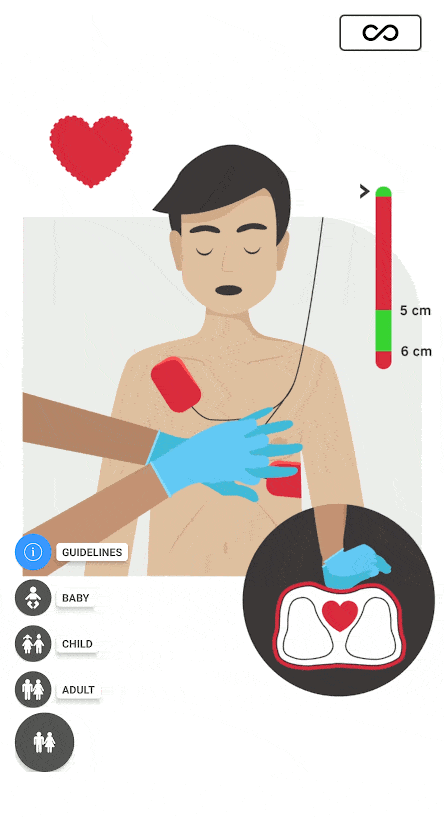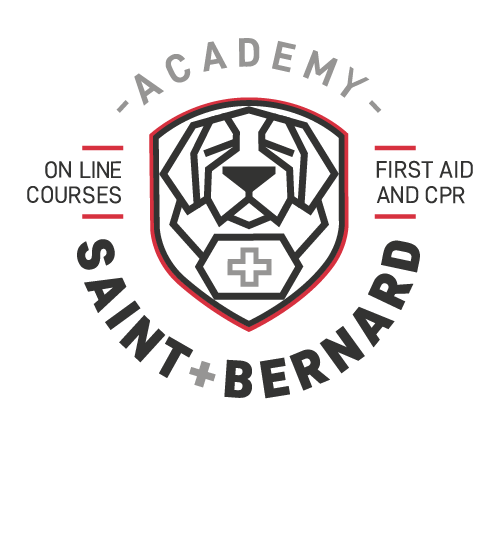GOOGLE PLAY ? HTTPS://BIT.LY/3GP5DTH
APP STORE ? HTTPS://APPLE.CO/34FYX1P

Starting the application
- The “RCR – ASB” application is a tool that enables rescuers to perform high-quality emergency cardiovascular care, ie CPR, in a situation of suspected or confirmed cardio-respiratory arrest.
- This application, unique in its kind, will allow its user to add a complementary tool when practicing CPR maneuvers. Since these practices are mandatory in order to obtain accreditation, the candidate can then benefit from this application in order to perfect his techniques.
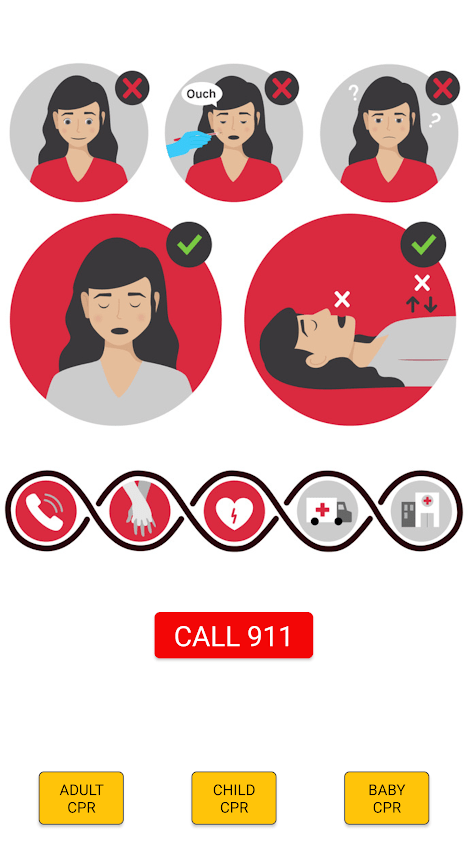
The home page
- As soon as the application opens, you will be asked to verify the need to contact emergency services. If you find yourself in a real emergency, you will be prompted to dial 911 without hesitation.
- The application will offer you three (3) categories of potential victims towards whom it would be possible to perform cardiopulmonary resuscitation maneuvers.
The victim’s condition
- Before starting resuscitation maneuvers, it is essential to ensure the victim’s condition. To do this, the rescuer will have to validate certain elements.

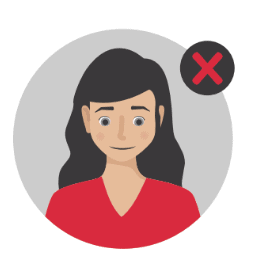
« A » Alert
- If the victim is alert, they will not require resuscitation. That’s why you’ll notice a red “X” in this illustration.

« V » Verbal
- If the victim responds to verbal stimuli, they will not require resuscitation. That’s why you’ll notice a red “X” in this illustration.
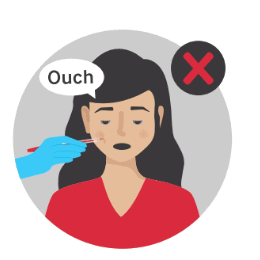
« P » Pain
- If the victim responds to painful stimuli, they will not require resuscitation. That’s why you’ll notice a red “X” in this illustration.
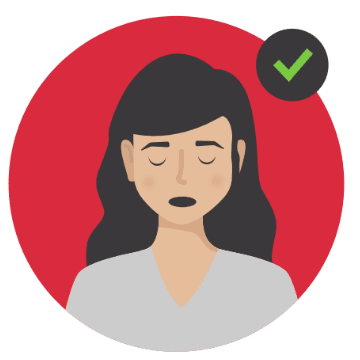
« U » Unconscious
- If the victim does not respond to any stimulus, there is a chance that he will require resuscitation. It is for this reason that you will find the presence of a green “check mark” in this illustration.
- In order to make sure that you need to start CPR maneuvers, you will need to assess one final item.
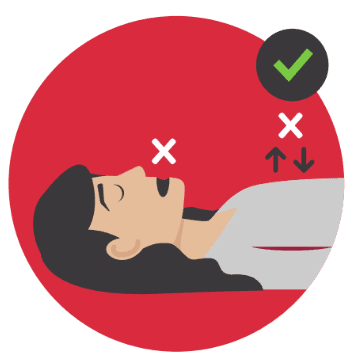
No breathing or agonal breathing
- If the victim is not breathing or does not appear to be breathing adequately, then CPR maneuvers should be started without hesitation. It is for this reason that you will find the presence of a green “check mark” in this illustration.
* Agonal breathing is a so-called “reflex” breathing generated by the brainstem. This results in a spasm of the respiratory muscles. This is not so-called “efficient” breathing.

911
- WARNING ! NEVER FORGET TO CONTACT THE EMERGENCY SERVICES!
- This action button will allow you to automatically exit the application in order to navigate to your phone application.
- The emergency number “911” will automatically appear on your screen, all you have to do is press the dial button to initiate the emergency call.
Steps to follow
- In a suspected or confirmed cardio-respiratory arrest situation, there are a few steps to follow. These steps must be followed rigorously in order to provide the maximum chance of survival for the victim.

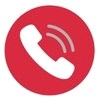
Call – 911
- As soon as a cardio-respiratory arrest is confirmed or suspected, immediately call the emergency services by dialing 911.

Chest compressions – CPR
- Begin high quality CPR maneuvers without hesitation by pushing hard and fast in the center of the victim’s breastbone.

Defibrillate – AED
- Request for a defibrillator (AED) and install it as soon as it is available.
- As soon as the electrodes are installed on the victim, let the defibrillator perform its analysis and then follow the instructions of the AED.
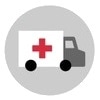
Emergency care
- The pre-hospital emergency services will be able to offer specific care allowing the victim to increase his chances of survival.
- Transport to a hospital center can then be carried out quickly and safely while carrying out the resuscitation maneuvers.
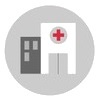
Advanced care
- The receiving hospital will carry out advanced clinical monitoring of the victim.
Categories of victims
- There are three (3) main categories of victims:
- Adults from the onset of signs of puberty, ie 12 years of age and over.
- Children, from the age of one (1) year until puberty (12 years).
- Infant, from discharge to the hospital until the age of one (1) year.




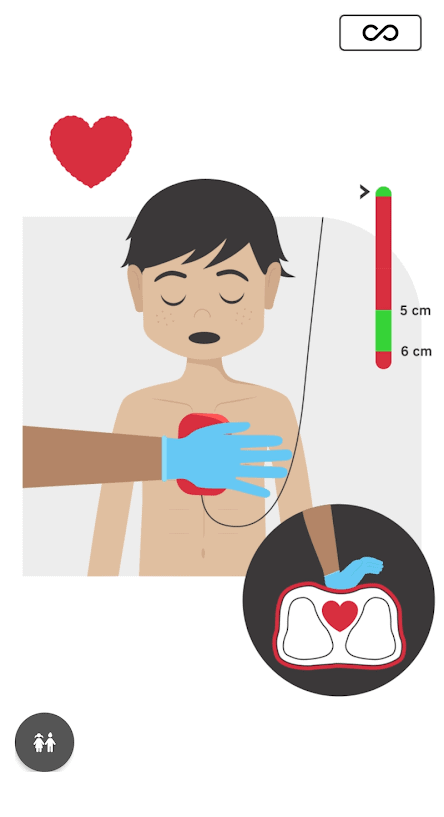

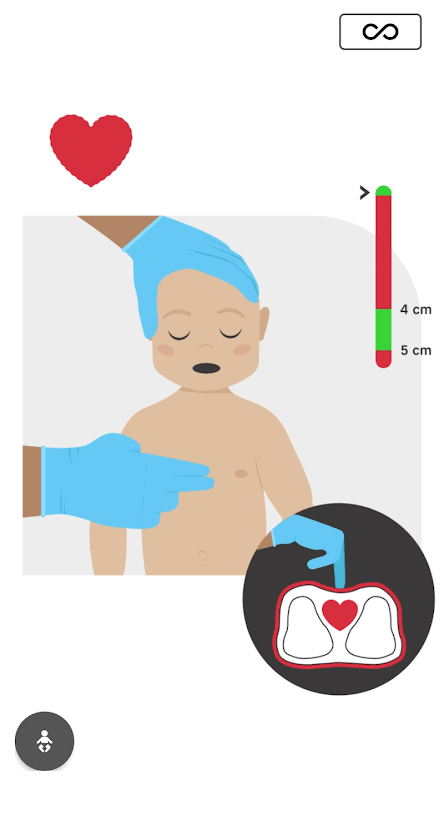
ADULT
Two (2) options
- For adults, two (2) options are available to you:
- Perform continuous chest compressions
- Perform maneuvers with a ratio of 30 chest compressions followed by 2 breaths



Continuous chest compressions
- When you choose to perform resuscitation maneuvers on an adult victim, you will automatically enter “Continuous chest compressions” mode.
- The “untrained” first responder can perform simple CPR maneuvers by pushing hard and fast in the center of the victim’s breastbone.

30 chest compressions then 2 breaths
- It will also be possible for the so-called “trained” rescuer to switch to “thirty (30) chest compressions followed by two (2) breaths” mode.
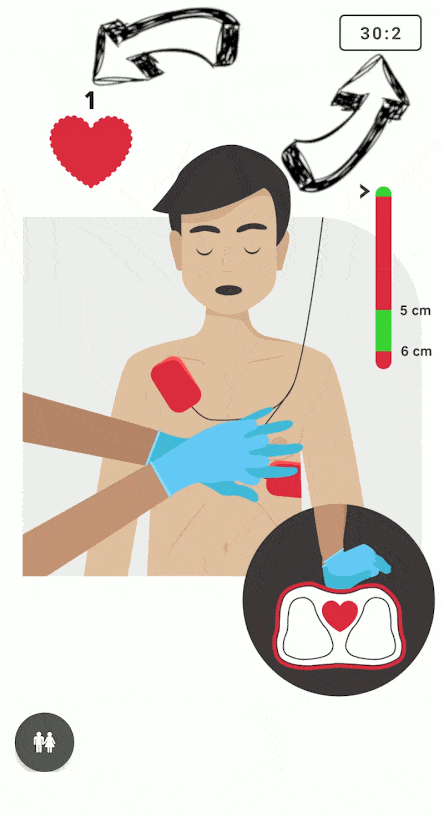
CHILDREN
Three (3) options
- For children, three (3) options are available to you:
- Perform continuous chest compressions
- Perform maneuvers with a ratio of 30 chest compressions followed by 2 breaths
- Perform maneuvers, when two (2) rescuers, with a ratio of 15 chest compressions followed by 2 breaths




Continuous chest compressions
- When you choose to perform resuscitation maneuvers in a child, you will automatically enter “Continuous chest compressions” mode.
- The “untrained” first responder can perform simple CPR maneuvers by pushing hard and fast in the center of the victim’s breastbone.

30 chest compressions then 2 breaths
- It will also be possible for the so-called “trained” rescuer to switch to “thirty (30) chest compressions followed by two (2) breaths” mode.

15 chest compressions then 2 breaths
- When two (2) rescuers are present, it will also be possible for so-called “trained” rescuers to switch to “fifteen (15) chest compressions followed by two (2) breaths” mode in a child.
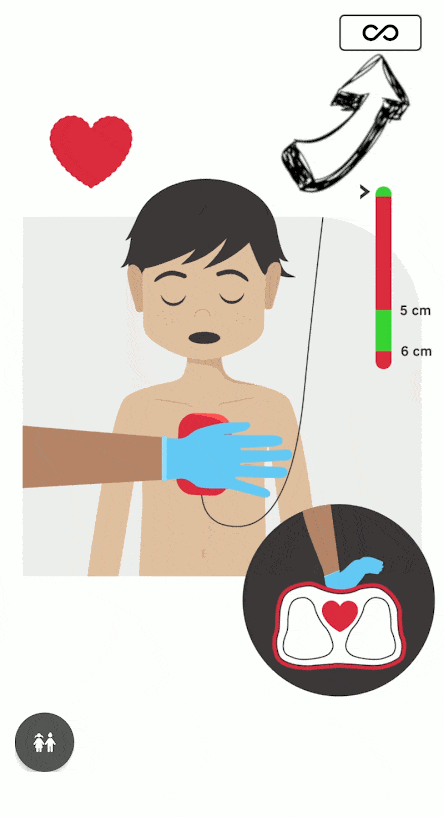
INFANT
Three (3) options
- In infants, three (3) options are available to you:
- Perform continuous chest compressions
- Perform maneuvers with a ratio of 30 chest compressions followed by 2 breaths
- Perform maneuvers, when two (2) rescuers, with a ratio of 15 chest compressions followed by 2 breaths




Continuous chest compressions
- When you choose to perform resuscitation maneuvers on an infant, you will automatically enter “Continuous chest compressions” mode.
- The “untrained” first responder can perform simple CPR maneuvers by pushing hard and fast in the center of the victim’s breastbone.

30 chest compressions then 2 breaths
- It will also be possible for the so-called “trained” rescuer to switch to “thirty (30) chest compressions followed by two (2) breaths” mode.

15 chest compressions then 2 breaths
- When two (2) rescuers are present, it will also be possible for so-called “trained” rescuers to switch to “fifteen (15) chest compressions followed by two (2) breaths” mode in an infant.
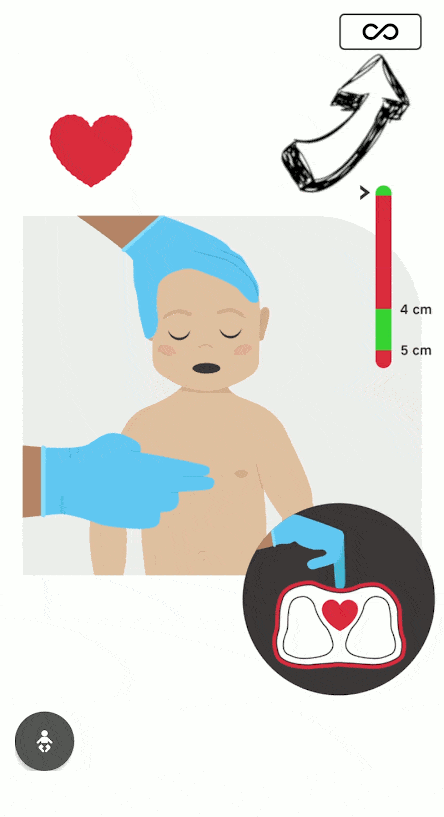
VENTILATIONS
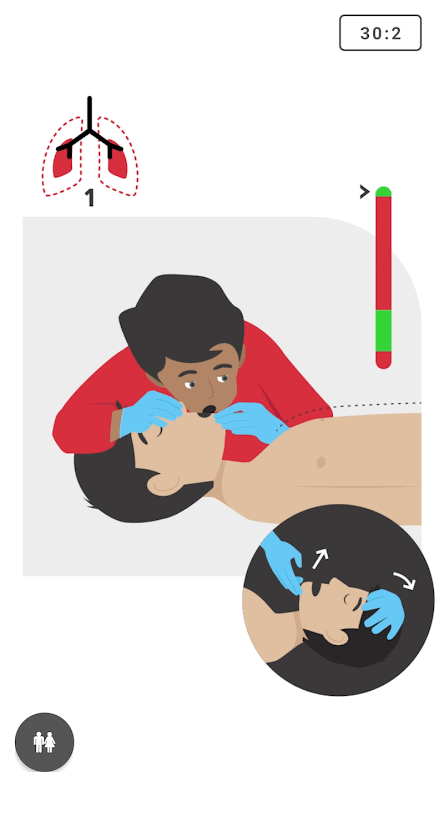
Adult – Ventilations
- The ventilations will only be displayed to you when performing maneuvers in “30: 2” mode.
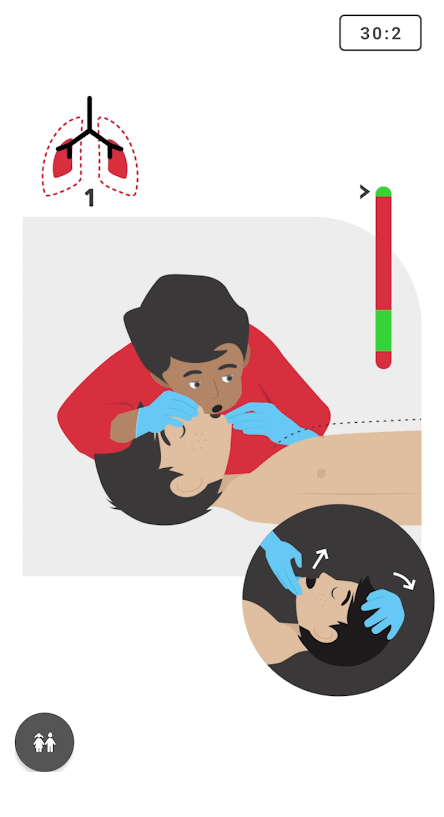
Children – Ventilations
- The ventilations will only be displayed to you when performing maneuvers in“30: 2” or “15: 2” mode.
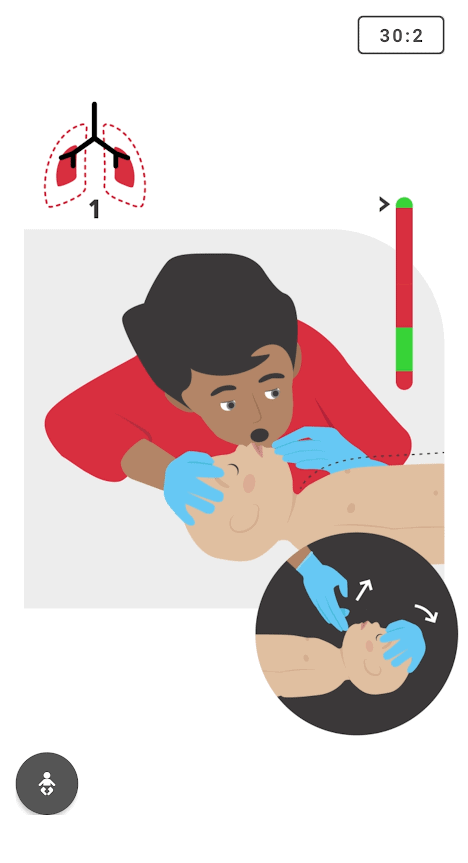
Infant – Ventilations
- The ventilations will only be displayed to you when performing maneuvers in“30: 2” or “15: 2” mode.
MENU
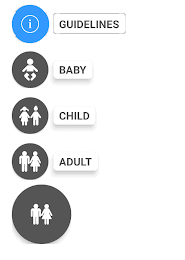
The choice of victim
- When you are in a resuscitation session, you can change your victim type at any time by using the menu at the bottom left of the screen.
